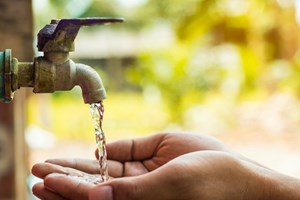Officials OK water in Hawaii neighborhood after leak
HONOLULU (AP) — The state Department of Health on Feb. 14 declared tap water in one Pearl Harbor neighborhood safe to drink more than two months after petroleum leaked from a Navy fuel storage facility, contaminated the drinking water supply and sickened thousands.
The department said residents in the Red Hill neighborhood may once again use their water. The area includes Red Hill Elementary School and 135 homes managed by the Army.
Eighteen other neighborhood zones remain under an advisory from the department saying their water is not safe to drink. The Navy’s water system serves about 93,000 people living and working in and around Pearl Harbor.
Officials came to the conclusion after verifying contaminated water was no longer entering the Navy’s water system, said Kathleen Ho, the department’s deputy director of environmental health. Officials have also flushed water pipes and tested water to make sure no contamination remains, she said.
Dr. Diana Felton, the state’s toxicologist, said trace levels of petroleum were found in one sample from the zone but did not rise above a threshold the department had set for safety.
Authorities tested samples from 10% of the homes in the zone before issuing the OK, in line with a plan approved by the department and the U.S. Environmental Protection Agency.
Petroleum from the Navy’s Red Hill Bulk Fuel Storage Facility leaked into a Navy drinking water well and entered the Navy’s water system in late November. Nearly 6,000 people were treated for complaints like nausea, headaches and rashes in the weeks after. About 4,000 military families have been living in hotels since early December.
The department has ordered the Navy to drain fuel from the tanks. The military has appealed that order.
The department said it would test the water in 5% of the area’s homes in the first three months, followed by 10% of homes every six months over the following two years.
Some families have expressed concern that testing a small percentage of homes wasn’t enough and said they wanted the water in all homes to be tested.
Felton said testing 10% of the homes provided a representative sample of the homes in the zone.
The Navy said in a news release that military leadership would notify zone residents of the change. The Navy didn’t immediately respond to a question about whether residents of this zone would lose hotel allowances provided to them after their water became contaminated.
Wayne Tanaka, the executive director of the Sierra Club of Hawaii, said he believes the families have legitimate fears and concerns about whether the water in their homes will be safe. Some homes may appear contamination-free even while others are tainted, he said.
“I would echo the concerns raised by the families who are now being asked to trust these assurances that their water will be safe. They’ve heard this before -- before hundreds, if not thousands, of people, including infants and children, were poisoned,” Tanaka said in an email.
Related News
From Archive

- Glenfarne Alaska LNG targets late-2026 construction start for 807-mile pipeline project
- U.S. water reuse boom to fuel $47 billion in infrastructure spending through 2035
- $2.3 billion approved to construct 236-mile Texas-to-Gulf gas pipeline
- Major water pipe break in Puerto Rico hits over 165,000 customers
- Potomac River Tunnel project enters construction phase beneath Washington, D.C.
- Pennsylvania American Water launches interactive map to identify, replace lead water service lines
- Trump's tariffs drive $33 million cost increase for Cincinnati sewer project
- Utah city launches historic $70 million tunnel project using box jacking under active rail line
- Tulsa residents warned after sewer lines damaged by boring work
- Fatal trench collapse halts sewer construction in Massachusetts; two workers hospitalized




Comments